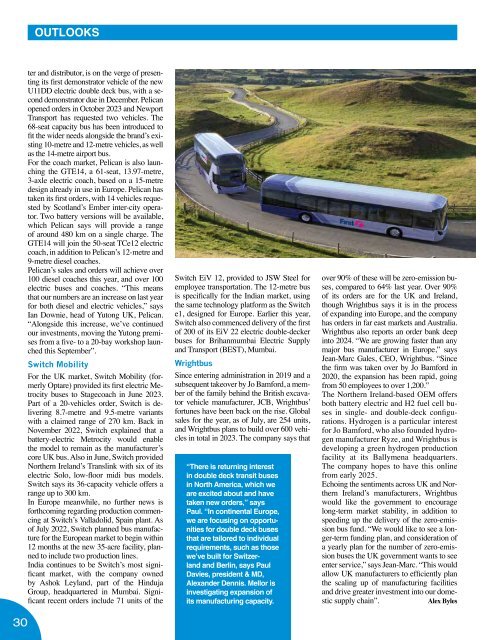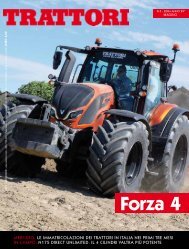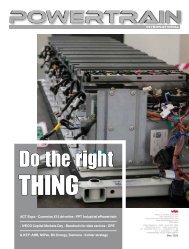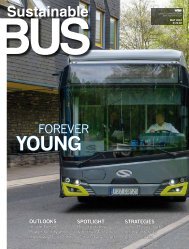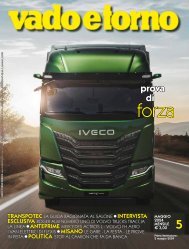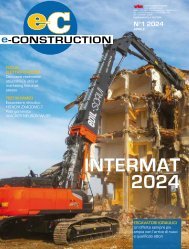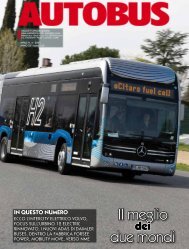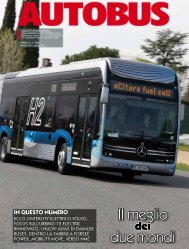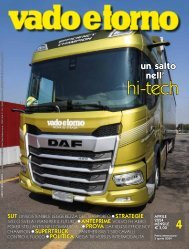2023-09 SUSTAINABLE BUS
A new issue of Sustainable Bus is out today. In this upcoming edition, we’ve curated a diverse and comprehensive range of topics that spotlight the latest developments in the world of sustainable mobility. From cutting-edge technological advancements to market insights and industry transformations, this issue promises to be a captivating exploration of the future of public transportation. What you could fine inside? Well, a market insight will offer you a detailed look at the European e-bus market, providing you with a comprehensive understanding of the mid-2023 results. The leading e-bus market in Europe is still UK: therefore, we focused our attention on that specific market with a report that sums up strategies, focus, goals of the most prominent industry players. A technology spotlight on the delicate topic of batteries, authored by Claudius Jehle, look at battery management and strategies to ensure the smooth and cost-effective operation of electric buses (with a focus on a case study from BVG). Among the pillars of our upcoming issue you’ll find a detailed journey around the European industrial bus&coach landscape. Goal? Providing our readers insights into the changing dynamics among key OEMs in the region. We’ll be then taking you behind the scenes at the Yutong factory in Zhengzhou, that we had the pleasure of visiting in June. Let’s then delve into Iveco Bus’s growing efforts in the zero-emission bus field. Finally, last but not least, a nearly-20-pages comparison between seven 12-meter battery-electric buses, gathered together in Bonn also this year by the German magazine Omnibusspiegel. You’ll find both established players and newcomers side by side: Ebusco 3.0, Hess lighTram 12m, Ikarus 120e, Iveco E-Way, Mercedes eCitaro with new batteries, Otokar e-Kent C, Quantron Cizaris 12 Ev.
A new issue of Sustainable Bus is out today. In this upcoming edition, we’ve curated a diverse and comprehensive range of topics that spotlight the latest developments in the world of sustainable mobility. From cutting-edge technological advancements to market insights and industry transformations, this issue promises to be a captivating exploration of the future of public transportation.
What you could fine inside? Well, a market insight will offer you a detailed look at the European e-bus market, providing you with a comprehensive understanding of the mid-2023 results. The leading e-bus market in Europe is still UK: therefore, we focused our attention on that specific market with a report that sums up strategies, focus, goals of the most prominent industry players.
A technology spotlight on the delicate topic of batteries, authored by Claudius Jehle, look at battery management and strategies to ensure the smooth and cost-effective operation of electric buses (with a focus on a case study from BVG).
Among the pillars of our upcoming issue you’ll find a detailed journey around the European industrial bus&coach landscape. Goal? Providing our readers insights into the changing dynamics among key OEMs in the region.
We’ll be then taking you behind the scenes at the Yutong factory in Zhengzhou, that we had the pleasure of visiting in June. Let’s then delve into Iveco Bus’s growing efforts in the zero-emission bus field.
Finally, last but not least, a nearly-20-pages comparison between seven 12-meter battery-electric buses, gathered together in Bonn also this year by the German magazine Omnibusspiegel. You’ll find both established players and newcomers side by side: Ebusco 3.0, Hess lighTram 12m, Ikarus 120e, Iveco E-Way, Mercedes eCitaro with new batteries, Otokar e-Kent C, Quantron Cizaris 12 Ev.
You also want an ePaper? Increase the reach of your titles
YUMPU automatically turns print PDFs into web optimized ePapers that Google loves.
OUTLOOKS<br />
30<br />
ter and distributor, is on the verge of presenting<br />
its first demonstrator vehicle of the new<br />
U11DD electric double deck bus, with a second<br />
demonstrator due in December. Pelican<br />
opened orders in October <strong>2023</strong> and Newport<br />
Transport has requested two vehicles. The<br />
68-seat capacity bus has been introduced to<br />
fit the wider needs alongside the brand’s existing<br />
10-metre and 12-metre vehicles, as well<br />
as the 14-metre airport bus.<br />
For the coach market, Pelican is also launching<br />
the GTE14, a 61-seat, 13.97-metre,<br />
3-axle electric coach, based on a 15-metre<br />
design already in use in Europe. Pelican has<br />
taken its first orders, with 14 vehicles requested<br />
by Scotland’s Ember inter-city operator.<br />
Two battery versions will be available,<br />
which Pelican says will provide a range<br />
of around 480 km on a single charge. The<br />
GTE14 will join the 50-seat TCe12 electric<br />
coach, in addition to Pelican’s 12-metre and<br />
9-metre diesel coaches.<br />
Pelican’s sales and orders will achieve over<br />
100 diesel coaches this year, and over 100<br />
electric buses and coaches. “This means<br />
that our numbers are an increase on last year<br />
for both diesel and electric vehicles,” says<br />
Ian Downie, head of Yutong UK, Pelican.<br />
“Alongside this increase, we’ve continued<br />
our investments, moving the Yutong premises<br />
from a five- to a 20-bay workshop launched<br />
this September”.<br />
Switch Mobility<br />
For the UK market, Switch Mobility (formerly<br />
Optare) provided its first electric Metrocity<br />
buses to Stagecoach in June <strong>2023</strong>.<br />
Part of a 20-vehicles order, Switch is delivering<br />
8.7-metre and 9.5-metre variants<br />
with a claimed range of 270 km. Back in<br />
November 2022, Switch explained that a<br />
battery-electric Metrocity would enable<br />
the model to remain as the manufacturer’s<br />
core UK bus. Also in June, Switch provided<br />
Northern Ireland’s Translink with six of its<br />
electric Solo, low-floor midi bus models.<br />
Switch says its 36-capacity vehicle offers a<br />
range up to 300 km.<br />
In Europe meanwhile, no further news is<br />
forthcoming regarding production commencing<br />
at Switch’s Valladolid, Spain plant. As<br />
of July 2022, Switch planned bus manufacture<br />
for the European market to begin within<br />
12 months at the new 35-acre facility, planned<br />
to include two production lines.<br />
India continues to be Switch’s most significant<br />
market, with the company owned<br />
by Ashok Leyland, part of the Hinduja<br />
Group, headquartered in Mumbai. Significant<br />
recent orders include 71 units of the<br />
Switch EiV 12, provided to JSW Steel for<br />
employee transportation. The 12-metre bus<br />
is specifically for the Indian market, using<br />
the same technology platform as the Switch<br />
e1, designed for Europe. Earlier this year,<br />
Switch also commenced delivery of the first<br />
of 200 of its EiV 22 electric double-decker<br />
buses for Brihanmumbai Electric Supply<br />
and Transport (BEST), Mumbai.<br />
Wrightbus<br />
Since entering administration in 2019 and a<br />
subsequent takeover by Jo Bamford, a member<br />
of the family behind the British excavator<br />
vehicle manufacturer, JCB, Wrightbus’<br />
fortunes have been back on the rise. Global<br />
sales for the year, as of July, are 254 units,<br />
and Wrightbus plans to build over 600 vehicles<br />
in total in <strong>2023</strong>. The company says that<br />
“There is returning interest<br />
in double deck transit buses<br />
in North America, which we<br />
are excited about and have<br />
taken new orders,” says<br />
Paul. “In continental Europe,<br />
we are focusing on opportunities<br />
for double deck buses<br />
that are tailored to individual<br />
requirements, such as those<br />
we’ve built for Switzerland<br />
and Berlin, says Paul<br />
Davies, president & MD,<br />
Alexander Dennis. Mellor is<br />
investigating expansion of<br />
its manufacturing capacity.<br />
over 90% of these will be zero-emission buses,<br />
compared to 64% last year. Over 90%<br />
of its orders are for the UK and Ireland,<br />
though Wrightbus says it is in the process<br />
of expanding into Europe, and the company<br />
has orders in far east markets and Australia.<br />
Wrightbus also reports an order bank deep<br />
into 2024. “We are growing faster than any<br />
major bus manufacturer in Europe,” says<br />
Jean-Marc Gales, CEO, Wrightbus. “Since<br />
the firm was taken over by Jo Bamford in<br />
2020, the expansion has been rapid, going<br />
from 50 employees to over 1,200.”<br />
The Northern Ireland-based OEM offers<br />
both battery electric and H2 fuel cell buses<br />
in single- and double-deck configurations.<br />
Hydrogen is a particular interest<br />
for Jo Bamford, who also founded hydrogen<br />
manufacturer Ryze, and Wrightbus is<br />
developing a green hydrogen production<br />
facility at its Ballymena headquarters.<br />
The company hopes to have this online<br />
from early 2025.<br />
Echoing the sentiments across UK and Northern<br />
Ireland’s manufacturers, Wrightbus<br />
would like the government to encourage<br />
long-term market stability, in addition to<br />
speeding up the delivery of the zero-emission<br />
bus fund. “We would like to see a longer-term<br />
funding plan, and consideration of<br />
a yearly plan for the number of zero-emission<br />
buses the UK government wants to see<br />
enter service,” says Jean-Marc. “This would<br />
allow UK manufacturers to efficiently plan<br />
the scaling up of manufacturing facilities<br />
and drive greater investment into our domestic<br />
supply chain”.<br />
Alex Byles


